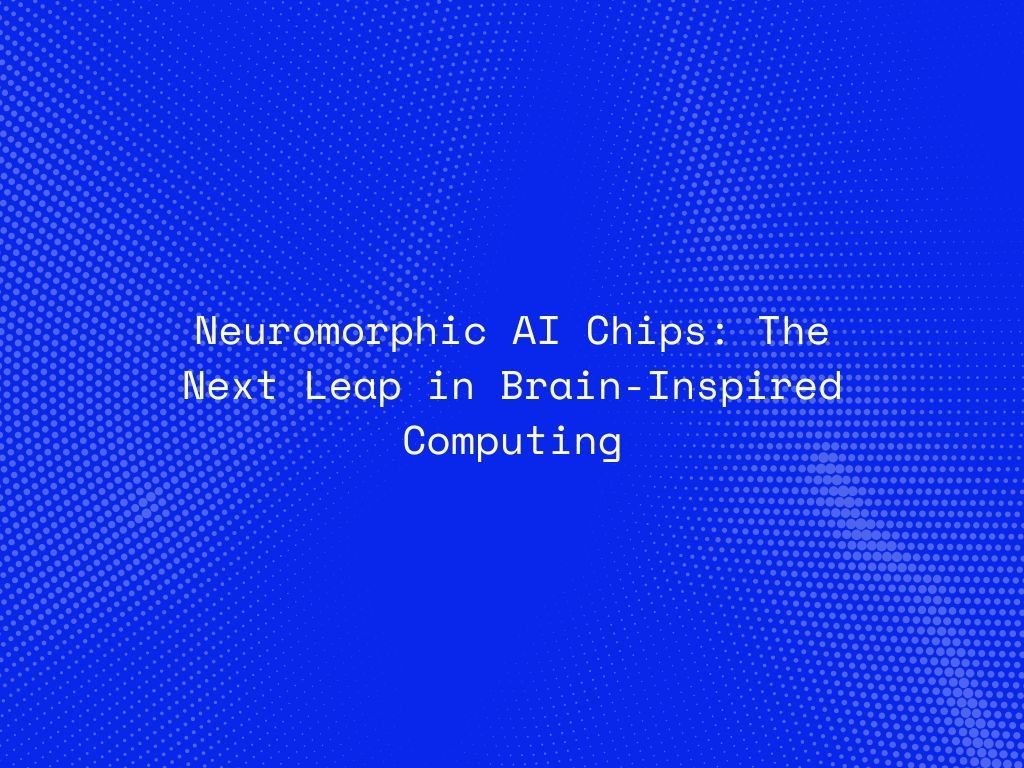As Artificial Intelligence continues to evolve, the demand for faster, more efficient, and intelligent computing systems has never been greater. Traditional computing architectures — based on the von Neumann model — are reaching their physical and performance limits. Enter neuromorphic computing, a transformative approach that mimics the structure and functionality of the human brain to enable machines that can process information more intelligently and efficiently.
At the heart of this revolution are neuromorphic AI chips — hardware designed to emulate the brain’s neural architecture, combining massive parallelism, event-driven computation, and ultra-low power consumption. These chips represent the next leap in AI hardware innovation, paving the way for truly intelligent, adaptive, and energy-efficient systems.
What Is Neuromorphic Computing?
Neuromorphic computing is a paradigm inspired by the way biological brains process information. Unlike conventional computers that separate memory and processing, neuromorphic systems integrate the two, allowing for continuous, parallel, and adaptive information flow — much like neurons and synapses in the brain.
In these systems, information is transmitted as electrical spikes — mimicking the brain’s event-driven communication. This design drastically reduces latency and power consumption while enabling real-time learning and inference, even in complex and dynamic environments.
How Neuromorphic AI Chips Work
Neuromorphic chips are built around artificial neurons and synapses that process and store information simultaneously. Each neuron communicates through spikes, and the strength of its connection — or synaptic weight — determines the learning behavior of the network.
This brain-inspired approach enables spiking neural networks (SNNs) — models that process data in time-dependent sequences rather than static layers, allowing the system to adapt based on patterns and context. These chips excel at tasks such as sensory processing, pattern recognition, and adaptive control, making them ideal for AI systems that must operate efficiently at the edge.
Why Traditional AI Hardware Falls Short
Conventional AI hardware, such as GPUs and TPUs, has driven massive advancements in deep learning. However, they face key limitations:
-
Energy Consumption: Training large models requires significant power, making them inefficient for continuous or real-time applications.
-
Latency and Memory Bottlenecks: The separation of memory and computation leads to slower data transfer and limited scalability.
-
Lack of Adaptability: Traditional hardware struggles with on-device learning and real-time adaptation.
Neuromorphic chips address these constraints by processing data locally, mimicking the brain’s distributed, event-driven approach. As a result, they can operate efficiently on small devices, even without constant cloud connectivity.
Key Players and Technological Advances
Several leading research organizations and tech companies are pioneering neuromorphic computing:
-
IBM’s TrueNorth: One of the earliest neuromorphic chips, TrueNorth contains over a million programmable neurons and consumes just 70 milliwatts of power — far less than traditional processors.
-
Intel’s Loihi: Designed for on-chip learning, Loihi supports real-time adaptation and energy-efficient inference, showing promise for robotics, sensor networks, and adaptive control systems.
-
BrainChip’s Akida: Targeted at edge AI applications, Akida enables ultra-low-power inference and learning for devices such as drones, smart cameras, and wearables.
These breakthroughs signal a shift toward hardware that not only processes information efficiently but also learns and evolves in real time.
Applications of Neuromorphic AI Chips
-
Edge AI and IoT Devices:
Neuromorphic chips enable intelligent processing at the edge, reducing dependence on cloud computing. Devices can analyze sensory data locally — from voice and vision to environmental signals — in real time. -
Autonomous Systems:
Self-driving cars, drones, and industrial robots require rapid decision-making with minimal energy. Neuromorphic chips can process sensor input and adjust behavior instantaneously, enhancing autonomy and safety. -
Healthcare and Wearables:
Brain-inspired chips are being explored for medical devices that monitor neural activity, predict seizures, or assist in prosthetic control, enabling more responsive and adaptive healthcare technologies. -
Smart Infrastructure:
In cities and industries, neuromorphic AI systems can interpret massive data streams from sensors to optimize energy use, traffic flow, and environmental monitoring with minimal computational load.
Advantages of Neuromorphic AI
-
Energy Efficiency: Operates with a fraction of the power required by GPUs.
-
Real-Time Adaptation: Learns from streaming data, enabling self-improving systems.
-
Scalability: Distributed processing mirrors the scalability of biological brains.
-
Reduced Data Dependency: Functions effectively with smaller datasets and fewer training cycles.
This makes neuromorphic computing particularly valuable for the next generation of AI systems, where sustainability and scalability are as important as speed and accuracy.
Challenges and the Road Ahead
Despite its promise, neuromorphic computing faces several challenges before mainstream adoption:
-
Software Ecosystem: Current AI frameworks are optimized for deep learning architectures, requiring new tools to support spiking neural networks.
-
Standardization: A lack of common benchmarks and architectures makes development fragmented.
-
Complexity of Modeling the Brain: Replicating biological neural dynamics remains a monumental scientific challenge.
As research progresses, hybrid systems combining neuromorphic, quantum, and traditional computing could emerge, each addressing different aspects of intelligence, efficiency, and scale.
Conclusion
Neuromorphic AI chips represent the next great frontier in computing — where hardware doesn’t just execute algorithms but learns, adapts, and evolves like the human brain. By bringing intelligence closer to the edge and drastically improving energy efficiency, these brain-inspired systems have the potential to revolutionize how machines perceive, reason, and interact with the world.
As the boundaries between biology and technology continue to blur, neuromorphic computing may not only redefine AI performance but also bring us closer to creating truly autonomous and cognitive machines.




